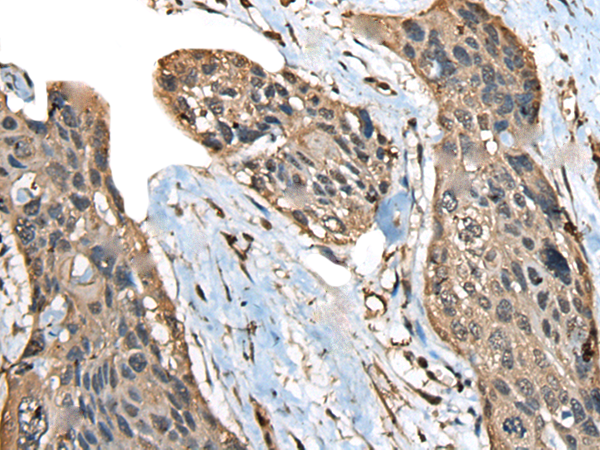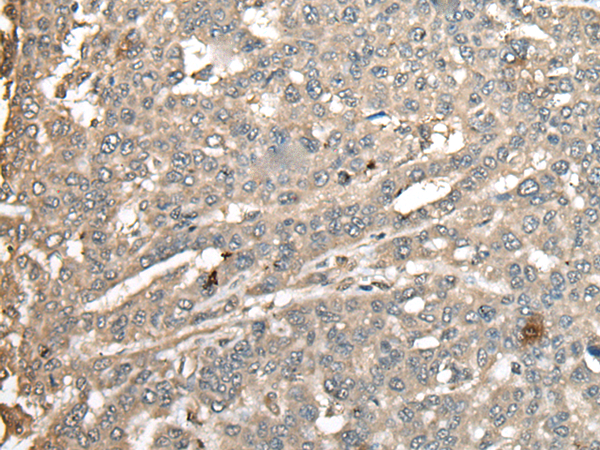

| WB | 咨询技术 | Human,Mouse,Rat |
| IF | 咨询技术 | Human,Mouse,Rat |
| IHC | 1/50-1/300 | Human,Mouse,Rat |
| ICC | 技术咨询 | Human,Mouse,Rat |
| FCM | 咨询技术 | Human,Mouse,Rat |
| Elisa | 1/5000-1/10000 | Human,Mouse,Rat |
| Aliases | AT3; JOS; MJD; ATX3; MJD1; SCA3 |
| Host/Isotype | Rabbit IgG |
| Antibody Type | Primary antibody |
| Storage | Store at 4°C short term. Aliquot and store at -20°C long term. Avoid freeze/thaw cycles. |
| Species Reactivity | Human |
| Immunogen | Fusion protein of human ATXN3 |
| Formulation | Purified antibody in PBS with 0.05% sodium azide and 50% glycerol. |
+ +
以下是3-4条关于ATXN3抗体的参考文献示例(内容为模拟,建议通过学术数据库验证原文):
1. **名称**:*Immunohistochemical localization of ataxin-3 in normal and SCA3 human brain*
**作者**:Schmidt T, et al.
**摘要**:研究利用ATXN3特异性抗体,揭示了ATXN3蛋白在正常人类脑组织中的广泛神经元表达,以及在SCA3患者脑内突变蛋白异常聚集的病理特征。
2. **名称**:*The role of ataxin-3 in the ubiquitin-proteasome pathway: Insights from antibody-based assays*
**作者**:Burnett BG, et al.
**摘要**:通过免疫印迹和免疫沉淀实验,验证ATXN3抗体在检测内源性ATXN3与泛素链结合中的作用,支持其参与调控蛋白质降解的分子机制。
3. **名称**:*A transgenic SCA3 mouse model recapitulates aggregate formation and neuronal dysfunction detected by ATXN3-specific antibodies*
**作者**:Paulson HL, et al.
**摘要**:利用ATXN3抗体在转基因小鼠模型中追踪突变蛋白的时空分布,证明其聚集体与运动功能障碍的相关性,为疾病机制研究提供工具。
4. **名称**:*Development of a single-chain antibody targeting expanded polyQ stretches in ATXN3*
**作者**:Evers MM, et al.
**摘要**:报道一种新型单链抗体选择性识别ATXN3多聚谷氨酰胺扩展结构,体外实验显示其可减少异常蛋白聚集,提示治疗潜力。
**注意**:以上为示例性内容,实际文献需通过PubMed等平台检索确认。建议使用关键词“ATXN3 antibody”、“anti-ataxin3”结合研究领域(如SCA3、polyglutamine)查找最新或高引论文。
**Background of ATXN3 Antibodies**
ATXN3 (ataxin-3) antibodies are essential tools for studying the ATXN3 protein, encoded by the *ATXN3* gene, which is linked to Machado-Joseph disease (MJD), also termed spinocerebellar ataxia type 3 (SCA3). This neurodegenerative disorder arises from a CAG trinucleotide repeat expansion in *ATXN3*, leading to an extended polyglutamine tract in the mutant protein. Wild-type ataxin-3 is a deubiquitinating enzyme involved in protein quality control, modulating the ubiquitin-proteasome system, and regulating cellular processes like transcription and endoplasmic reticulum stress.
ATXN3 antibodies enable the detection and characterization of both normal and pathogenic forms of the protein. They are widely used in research to investigate SCA3 pathogenesis, particularly how polyglutamine-expanded ataxin-3 forms toxic aggregates, disrupts proteostasis, and induces neuronal dysfunction. These antibodies support techniques such as Western blotting, immunohistochemistry, and immunofluorescence to analyze protein expression, localization, and aggregation patterns in cellular and animal models. Additionally, they aid in studying ataxin-3’s interactions with other proteins (e.g., ubiquitin chains, chaperones) and its role in DNA repair or transcriptional regulation.
The development of specific ATXN3 antibodies has advanced therapeutic research, including strategies to reduce toxic aggregates or enhance protein clearance. Their utility extends to diagnostic applications, such as confirming *ATXN3* mutations in clinical samples. By elucidating molecular mechanisms in SCA3. ATXN3 antibodies remain critical for understanding polyglutamine disorders and developing targeted therapies.
×